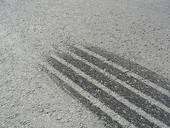Stopping in an Emergency
 In normal conditions a good driver should not need to brake really hard. However, emergencies can happen – for instance, when a child runs out in the street in front of you- so you must know how to stop quickly under control. Stopping in an emergency increases the risk of skidding, follow the rule of progressive braking- pushing the brake pedal harder as the vehicle slows down.
In normal conditions a good driver should not need to brake really hard. However, emergencies can happen – for instance, when a child runs out in the street in front of you- so you must know how to stop quickly under control. Stopping in an emergency increases the risk of skidding, follow the rule of progressive braking- pushing the brake pedal harder as the vehicle slows down.
A quick reaction is crucial in an emergency. The sooner you start braking the sooner you should stop.
Practise the following routine:
- Keep both hands on the steering wheel, you need as much control as possible.
- Avoid braking so hard that you lock any wheels. A skid sideways or a wheel sliding may cause serious loss of control.
- Don’t touch the clutch pedal until just before you stop. This helps with your braking and stability.
- Don’t touch the parking brake. Most parking brakes work on the back wheels only. Extra braking here can cause skidding.
Practise braking to judge the correct pressure and remember to take into account road and weather conditions. If the road is dry, you should apply firm pressure, but on a wet road of loose surface you should avoid using too much. This means that you will need to reduce speed and increase your separation distance from vehicle in front.
When braking in an emergency:
- Don’t signal – You need both hands on the wheel to control the steering.
- Don’t make a special point of looking in the mirror – you should know what’s behind anyway.
- Stop as quickly as possible and safely as possible, keeping your vehicle under full control.
- Look all round before moving off again.
Note! If you are not moving off straight away, put your parking brake on and the gear level in neutral.
Defensive Driving – Try to avoid the emergency arising
- Look well ahead.
- Watch for children playing.
- Remember school times.
- Look out for pedestrians
- Look for clues, such as reflections.
Always drive at such a speed that you can stop safely in the distance you can see to be clear. If it is not clear Slow Down. Prepare for the unexpected.
Progressive Braking:
This is a safe driving technique which:
- Allows other drivers time to react.
- Prevents locked wheels.
- Prevents skidding.
- Saves wear and tear on brakes, tyres and suspension.
- Saves fuel.
- Is more comfortable for your passengers.
To Brake Progressively:
- Put light pressure on the brakes.
- Gradually increase the pressure required to stop the vehicle.
- When the vehicle has almost stopped, ease off the pressure so that the vehicle stops smoothly. There should be little or no pressure as the vehicle actually stops.
Practise:
Choose a particular point at which you would like to stop. See how near to it you can get.
It’s better to stop short of the mark rather than overshoot it. You can always ease off the brakes and run forward a bit more. Stopping at a kerb needs practise too. Aim to stop reasonably close to the kerb without hitting it.
Both hands should be on the steering wheel.